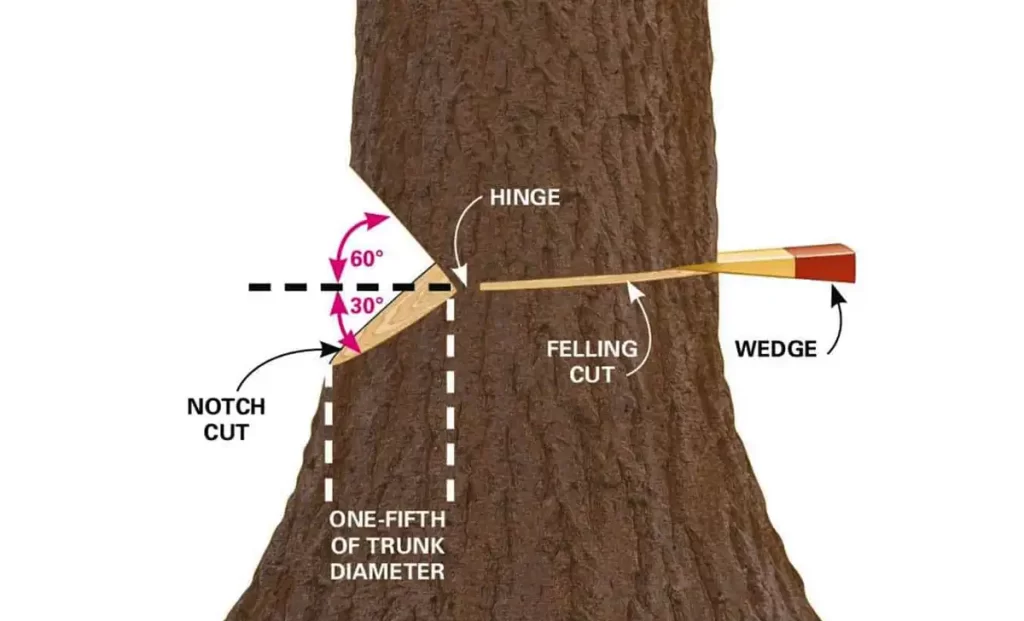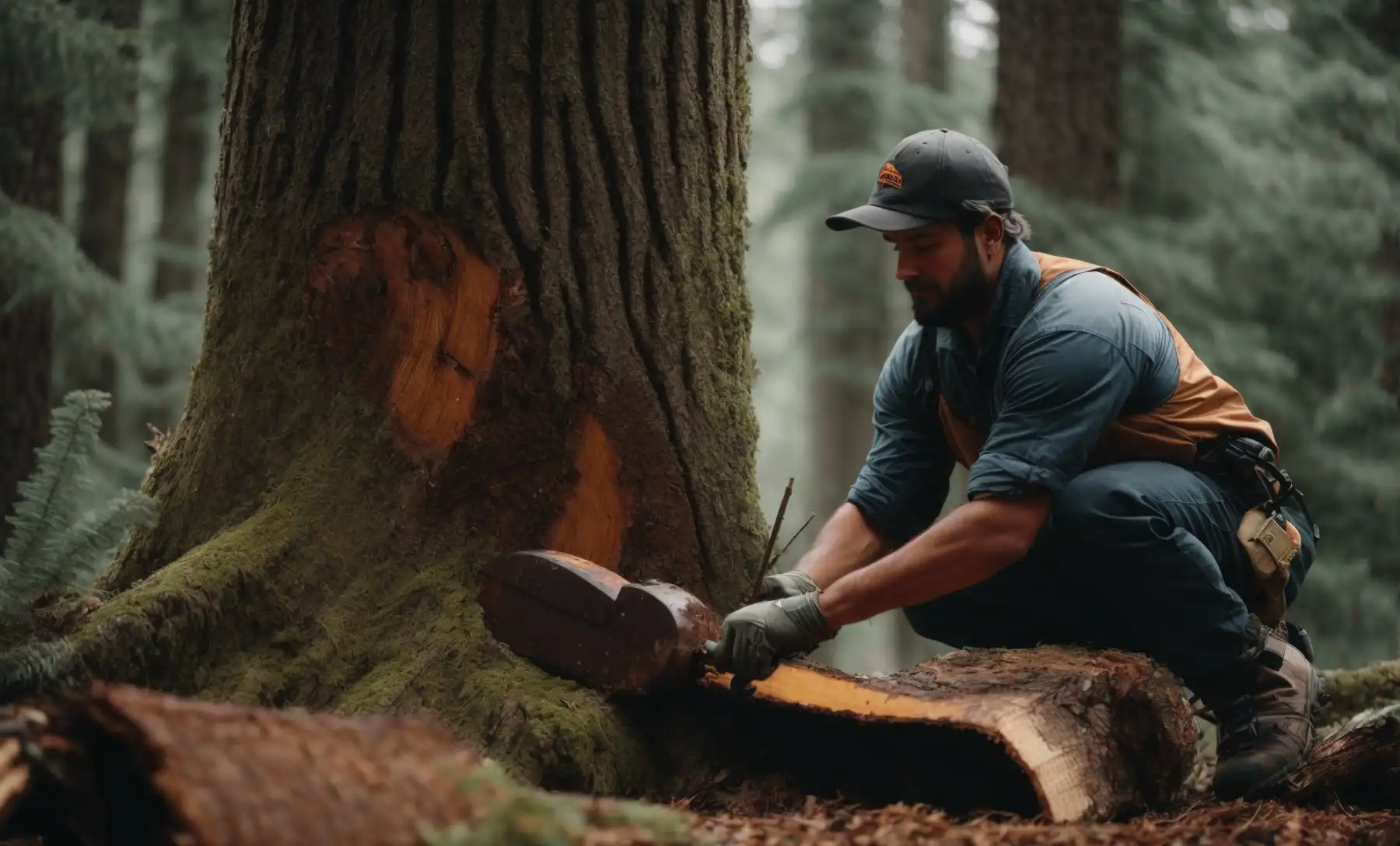To cut down a tree with a chainsaw, first establish a clear cutting plan and wear protective gear. Ensure the chainsaw’s sharpness and check for any obstacles or hazards in the felling direction.
Cutting down a tree is a task that requires precision, safety precautions, and the right equipment. Utilizing a chainsaw for this purpose involves a series of steps beginning with a thorough assessment of the tree and the surrounding area. Safety is paramount, so equipping oneself with the necessary protective gear, such as a helmet, gloves, and eye and ear protection, is non-negotiable.
A chainsaw must be in prime condition, with a sharp blade to ensure efficiency and reduce the risk of kickback—a common and dangerous occurrence. The process also demands awareness of escape paths and environmental considerations to avoid property damage or injuries. Understanding the correct cutting techniques, including the creation of a notch cut and the back cut, guides the tree’s fall direction and facilitates a controlled and predictable descent. This introduction sets the stage for a safe and successful tree removal, detailing a strategic approach that prioritizes personal safety and environmental care.

About Tree Cutting With Chainsaws
Felling trees is an intense task where power meets nature. Chainsaws, the go-to tool for this job, combine raw cutting power with finesse. But knowing how to wield this power safely and effectively is crucial. In this post, we’ll dissect the process of tree cutting with a chainsaw, covering operation basics, safety, and when to call the experts.
Understanding the Basics of Chainsaw Operation
Before starting your chainsaw, it’s vital to understand its parts. Each component, from the sharp chain to the sturdy handle, plays a role in safe operation. Start by reading the manual. It guides on starting, handling, and maintaining your chainsaw. Next, practice holding and balancing it without power. Familiarizing yourself with the feel of the chainsaw ensures better control during the actual cut.
The Importance of Safety When Cutting Down Trees
Safety can’t be overstressed. Chainsaws are powerful and, if misused, dangerous. Always wear safety gear—helmet, goggles, gloves, ear protection, and anti-cut chaps. Clear the area around the tree and plan your escape path. Secure a firm footing and never cut alone. Keep others at a distance, at least twice the tree’s height. Maintain a sharp chain; a dull one can cause kickback, a common cause of chainsaw-related injuries.
Assessing the Need for Professional Arborists
Sometimes, a job requires more than enthusiasm and a chainsaw. Large trees, those near power lines or buildings, often necessitate professional skill. Certified arborists have the training and equipment to take down trees safely and efficiently. Signs you might need an expert include:
- Tree height beyond your comfort level.
- Dense branches that require precision cutting.
- Decay or disease that makes the tree unstable.
- Proximity to hazards like power lines or homes.
Preparation For Tree Cutting
Before you start your chainsaw, a thorough preparation is vital to ensure a safe and efficient tree cutting experience. This preparation involves selecting the right equipment, assessing the tree and area, and making sure you have the correct safety gear. You also need to handle permit-related concerns. Let’s dive into the crucial steps of preparations you can’t overlook.
Selecting the Right Chainsaw For The Job
Choosing the ideal chainsaw is crucial for cutting down a tree effectively. Consider factors such as:
- Tree Size: A larger chainsaw blade for big trees, a smaller one for thinner trees.
- Chainsaw Type: Gas chainsaws offer power, while electric models are quieter and lighter.
- User Experience: If you’re new, opt for a chainsaw with safety features and easy handling.
Match your chainsaw’s features with the task at hand to ensure smooth operation.
Evaluating the Tree’s Condition and Surrounding Area
Inspect the tree and its surroundings to identify potential hazards. Look for:
- Tree Health: Rotten or weak spots may affect the fall direction.
- Lean Direction: Natural tilt indicates the easiest fall direction.
- Obstacles: Clear the area of buildings, power lines, and other trees.
- Escape Path: Plan two escape routes opposite the fall direction.
Understanding the environment helps you anticipate and mitigate risks.
Gathering Essential Safety Gear and Tools
Safety must be your top priority. Equip yourself with:
- Safety Helmet: Prevents head injuries.
- Earmuffs: Protects hearing from chainsaw noise.
- Goggles: Shields eyes from sawdust and debris.
- Gloves: Offers a firm grip and hand protection.
- Chainsaw Chaps: Protects legs against cuts.
- First Aid Kit: For immediate medical response if needed.
Do not overlook any safety equipment to minimize the risks of accidents.
Obtaining Necessary Permits and Clearances
Check local regulations before cutting down a tree. You may need:
- Permit Application: Some areas require a cutting permit;
- Property Lines: Ensure the tree is on your land;
- Neighborhood Clearances: Inform neighbors if necessary.
Avoid legal issues by securing all the needed approvals in advance.
Cutting Techniques and Strategies
Felling a tree with a chainsaw requires both precision and a strategic approach. To ensure a safe and efficient cut, specific techniques and strategies are vital. In the following sections, we discuss key steps like planning the takedown direction, preparing your escape route, executing accurate cuts, and managing the tree’s lean and weight.
Determining the Felling Direction
Choosing the right direction to fell a tree is crucial. It directs the tree’s fall and minimizes risk. To settle on the felling direction, consider the following pointers:
- Natural lean of the tree: Favor the tree’s natural direction.
- Surrounding area: Avoid buildings, power lines, and other obstacles.
- Wind direction: Factor in the wind to ensure a successful fall.
Clearing Escape Routes and Safety Zones
Safety is non-negotiable. Establish clear escape routes and zones:
- Escape route: Plan two paths, opposite to the falling direction.
- Safety zone: Keep a distance of at least 15 feet from the tree base.
Making Precise Cuts: Notches and the Felling Cut
Cuts determine the fall. Ensure your notches and felling cut are on point.
- Face notch: Cut at a 70-degree angle, one-quarter into the tree.
- Back cut: Make the felling cut slightly above the notch bottom.
Managing Tree Lean and Weight Distribution
A tree’s lean and distribution affect its fall. Use these tips:
| Condition | Strategy |
|---|---|
| Forward lean | Apply wedges to steer and control the fall. |
| Side lean | Use ropes or mechanical assistance when needed. |
| Even weight distribution | Proceed with the standard felling technique. |
Finishing the Job Safely
When it comes to finishing the job safely, meticulous care is vital. Cutting down a tree with a chainsaw requires attention to detail, especially during the final stages. Safety must be your top priority as missteps can be hazardous. This guide will walk you through the steps to conclude your tree cutting task efficiently and without harm.
Executing the Final Cut and Retreat
The last cut is critical for both the tree’s direction of fall and your safety. Position yourself to the side, maintaining a firm grip on the chainsaw with both hands. Create a cutting plan that ensures a clear escape path. Aim for a directional notch cut that guides the tree to fall in the desired direction. As the tree begins to fall, move swiftly and safely away using your pre-planned retreat path.
- Check the wind direction. It influences the tree’s fall.
- Make a clear notch cut. It directs the fall.
- Move away quickly. Use the escape path.
Dealing With Tree Hang-Ups and Partial Cuts
Sometimes, a tree might not fall as expected. Hang-ups or partial cuts can occur, leaving the tree in a precarious position. If this happens, do not attempt to cut through from the same spot. Stop, turn off the chainsaw, and evaluate the situation. Seek professional help if necessary, and consider using ropes or wedges to complete the job safely.
Limbing and Bucking the Fallen Tree
Once the tree is on the ground, the task shifts to limbing and bucking. Start by removing the branches, or ‘limbs,’ to clear your way to the main trunk. Next, ‘buck’ the tree by cutting it into sections. Always work from the side opposite the cutting area, maintaining a secure stance and awareness of your surroundings.
- Switch off chainsaw before approaching the fallen tree.
- Begin limbing from the bottom up, away from the trunk.
- Cut the trunk into sections, watching for kickback.
Learn more: How to Clean a Chainsaw
Post-tree Cutting Considerations
Felling a tree is like completing a major project. After the chainsaw has done its job and the tree lies grounded, important steps follow to ensure a safe and clean environment. Addressing these steps can prevent accidents, promote nature’s health, and extend your chainsaw’s life.
Cleaning Up the Work Area
Clearing debris is crucial for safety. Gather branches and leaves for disposal or repurposing. Create a clear path to avoid tripping hazards. Use gloves and sturdy boots during cleanup.
Tree Stump Removal Options
- Stump grinding: Fast but requires machinery.
- Chemical treatments: They’re slower but less labor-intensive.
- Burning: Quick but risky and often not recommended.
Environmental Impact and Replanting
Consider biodiversity when removing trees. Replant a new tree to maintain balance. Choose species that are native and beneficial to the local ecosystem.
Proper Chainsaw Maintenance After Use
- Clean the chainsaw thoroughly, removing debris.
- Inspect for damages or dull blades and repair as needed.
- Store in a dry, safe place to prevent rust and damage.
Conclusion
Safely cutting down a tree requires caution and the right technique. With your chainsaw ready, follow the steps outlined for an effective and secure tree removal process. Remember, proper gear and a clear plan are your best allies. When in doubt, consult a professional.
Chainsaw Hive is where enthusiasts unite. Dive into our Knowledge category for the latest, in-depth chainsaw trends and tips. Happy and safe cutting!
